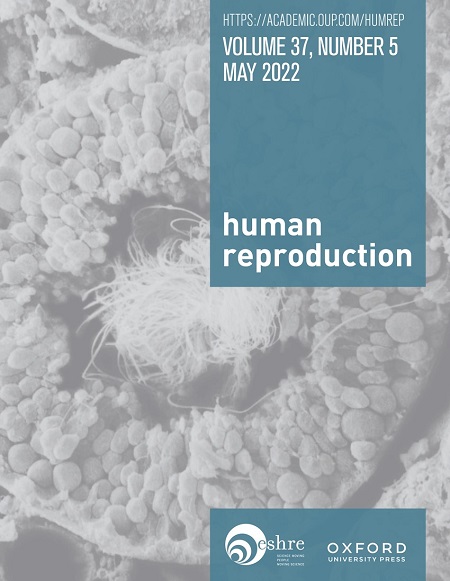Optimizing Y-chromosome microdeletion screening in Chinese male infertility patients: a large-scale multi-centre study on incidence
IF 6
1区 医学
Q1 OBSTETRICS & GYNECOLOGY
引用次数: 0
Abstract
STUDY QUESTION What is the optimal sperm concentration threshold for screening Y-chromosome microdeletions (YCMs) in male infertility patients? SUMMARY ANSWER This study identified three clinically relevant screening thresholds: an receiver operating characteristic (ROC)-optimal cutoff at 0.45 million sperm/ml, a high-sensitivity cutoff at 8 million sperm/ml, and a cost-effective threshold at 1 million sperm/ml. WHAT IS KNOWN ALREADY YCMs are the second most common genetic cause of male infertility, however, current screening thresholds remain controversial due to limited supporting evidence. STUDY DESIGN, SIZE, DURATION This retrospective multi-centre cohort study included 6806 male patients who underwent fertility assessments and azoospermia factor (AZF) gene testing between September 2013 and January 2024. PARTICIPANTS/MATERIALS, SETTING, METHODS ROC analysis was used to determine the AUC to show the effectiveness of sperm concentration for predicting AZF deletions. The sensitivity and specificity of different sperm concentration screening thresholds were measured. MAIN RESULTS AND THE ROLE OF CHANCE The incidence of YCMs was found to be 12.71% in non-obstructive azoospermia patients, 13.35% in patients with sperm concentrations between 0 and 1 million/ml, and 3.56% in those between 1 and 5 million/ml. ROC analysis demonstrated that sperm concentration was a good predictor of AZF deletions (AUC: 0.75, 95% CI: 0.74–0.77). The optimal threshold of 0.45 million/ml yielded a sensitivity of 86.84%, specificity of 59.97%, positive predictive value (PPV) of 13.48%, and negative predictive value (NPV) of 98.45%. A threshold of 8 million/ml achieved maximum sensitivity of 100.00% and NPV of 100.00%, but with specificity of 30.32% and PPV of 9.34%. The model showed good calibration with a Brier score of 0.06 and a goodness-of-fit test P-value of 0.726. Cost-effectiveness analysis revealed that a threshold of 1 million/ml provided the lowest incremental cost-effectiveness ratio. LIMITATIONS, REASONS FOR CAUTION Firstly, despite being the largest cohort study to date, our data primarily originated from eastern China, particularly the Zhejiang region. A nationwide multi-centre study could further validate our findings across different Chinese populations. Secondly, our cost-effectiveness analysis uses general gross domestics product-based willingness-to-pay thresholds, while disease-specific thresholds might be more appropriate and could be explored through nationwide surveys. Moreover, it is important to note that our cost-effectiveness findings are specifically based on the Chinese healthcare system and may not be directly applicable to other countries due to variations in healthcare systems, insurance coverage, and patient payment responsibilities across different regions globally. Another limitation of our cost-effectiveness analysis is that it may not fully capture the complex downstream implications of YCM detection in non-azoospermic men, where the primary impact relates to reproductive choices. Future studies should consider incorporating intergenerational effects and the potential costs of ART in subsequent generations when evaluating the true cost-effectiveness of YCM screening strategies. Thirdly, while we rigorously excluded cases with obstructive factors, the retrospective nature of our study might have introduced an inherent selection bias that could be addressed in future prospective studies. Fourthly, due to challenges in data collection, precise information on abstinence duration for some patients was unavailable and, therefore, not included in this article. We plan to further explore their potential impact on our conclusions in future prospective studies. WIDER IMPLICATIONS OF THE FINDINGS This large-scale study provides comprehensive evidence for optimizing YCM screening strategies in male infertility evaluations. STUDY FUNDING/COMPETING INTEREST(S) This project was supported by the Medical and Health Technology Program of Zhejiang Province (2025KY085), the Zhejiang Health Information Association Research Program (2024XHSZ-Z05), the Scientific Research Fund of Zhejiang Provincial Education Department (Y202249537), and the National Natural Science Foundation of China (82471638). There are no known competing interests. TRIAL REGISTRATION NUMBER N/A.优化中国男性不育症患者的y染色体微缺失筛查:一项发生率的大规模多中心研究
研究问题:筛选男性不育症患者y染色体微缺失(YCMs)的最佳精子浓度阈值是多少?本研究确定了三个临床相关的筛查阈值:接受者工作特征(ROC)-最佳临界值为45万精子/ml,高灵敏度临界值为800万精子/ml,成本效益临界值为100万精子/ml。YCMs是男性不育的第二大常见遗传原因,然而,由于支持证据有限,目前的筛查阈值仍然存在争议。研究设计、规模、持续时间这项回顾性多中心队列研究包括6806名男性患者,他们在2013年9月至2024年1月期间接受了生育评估和AZF基因检测。受试者/材料,设置,方法采用ROC分析确定AUC,以显示精子浓度预测AZF缺失的有效性。测定不同精子浓度筛查阈值的敏感性和特异性。非梗阻性无精子症患者中ycm的发生率为12.71%,精子浓度为0 ~ 100万/ml的患者中为13.35%,100 ~ 500万/ml的患者中为3.56%。ROC分析表明,精子浓度是AZF缺失的良好预测因子(AUC: 0.75, 95% CI: 0.74-0.77)。最佳阈值为45万/ml,灵敏度为86.84%,特异性为59.97%,阳性预测值为13.48%,阴性预测值为98.45%。阈值为800万/ml,灵敏度为100.00%,NPV为100.00%,特异性为30.32%,PPV为9.34%。模型具有良好的校正效果,Brier评分为0.06,拟合优度检验p值为0.726。成本效益分析显示,100万/ml的阈值提供了最低的增量成本效益比。首先,尽管是迄今为止最大的队列研究,我们的数据主要来自中国东部,特别是浙江地区。一项全国性的多中心研究可以进一步验证我们在不同中国人群中的发现。其次,我们的成本效益分析使用一般的基于国内生产总值的支付意愿阈值,而特定疾病的阈值可能更合适,可以通过全国调查来探索。此外,值得注意的是,我们的成本效益研究结果是专门基于中国医疗保健系统的,由于全球不同地区的医疗保健系统、保险覆盖范围和患者支付责任的差异,可能无法直接适用于其他国家。我们的成本效益分析的另一个限制是,它可能没有完全捕捉到在非无精子男性中检测YCM的复杂下游影响,其中主要影响与生殖选择有关。在评估YCM筛查策略的真正成本效益时,未来的研究应考虑纳入代际效应和后代抗逆转录病毒治疗的潜在成本。第三,虽然我们严格排除了具有阻碍因素的病例,但我们研究的回顾性性质可能会引入固有的选择偏差,这可以在未来的前瞻性研究中解决。第四,由于数据收集方面的挑战,一些患者的禁欲持续时间的精确信息是不可用的,因此,没有包括在这篇文章中。我们计划在未来的前瞻性研究中进一步探讨它们对我们结论的潜在影响。这项大规模研究为优化男性不育评估中的YCM筛查策略提供了全面的证据。浙江省医药卫生科技计划项目(2025KY085)、浙江省卫生信息协会科研计划项目(2024XHSZ-Z05)、浙江省教育厅科研基金项目(Y202249537)、国家自然科学基金项目(82471638)资助。没有已知的竞争利益。试验注册号n / a。
本文章由计算机程序翻译,如有差异,请以英文原文为准。
求助全文
约1分钟内获得全文
求助全文
来源期刊

Human reproduction
医学-妇产科学
CiteScore
10.90
自引率
6.60%
发文量
1369
审稿时长
1 months
期刊介绍:
Human Reproduction features full-length, peer-reviewed papers reporting original research, concise clinical case reports, as well as opinions and debates on topical issues.
Papers published cover the clinical science and medical aspects of reproductive physiology, pathology and endocrinology; including andrology, gonad function, gametogenesis, fertilization, embryo development, implantation, early pregnancy, genetics, genetic diagnosis, oncology, infectious disease, surgery, contraception, infertility treatment, psychology, ethics and social issues.
 求助内容:
求助内容: 应助结果提醒方式:
应助结果提醒方式:


